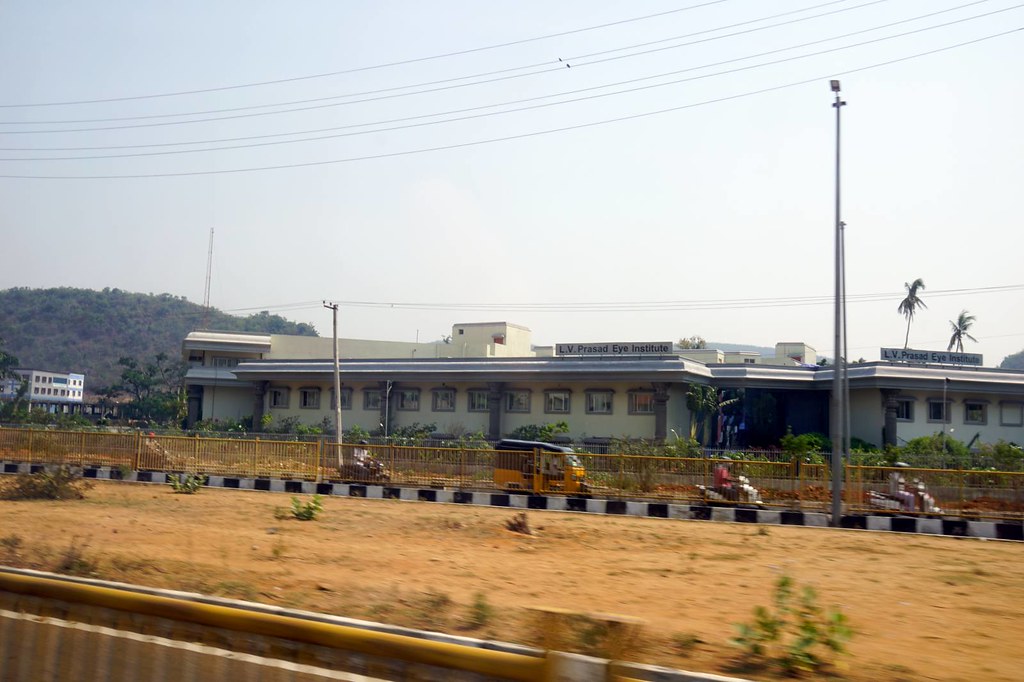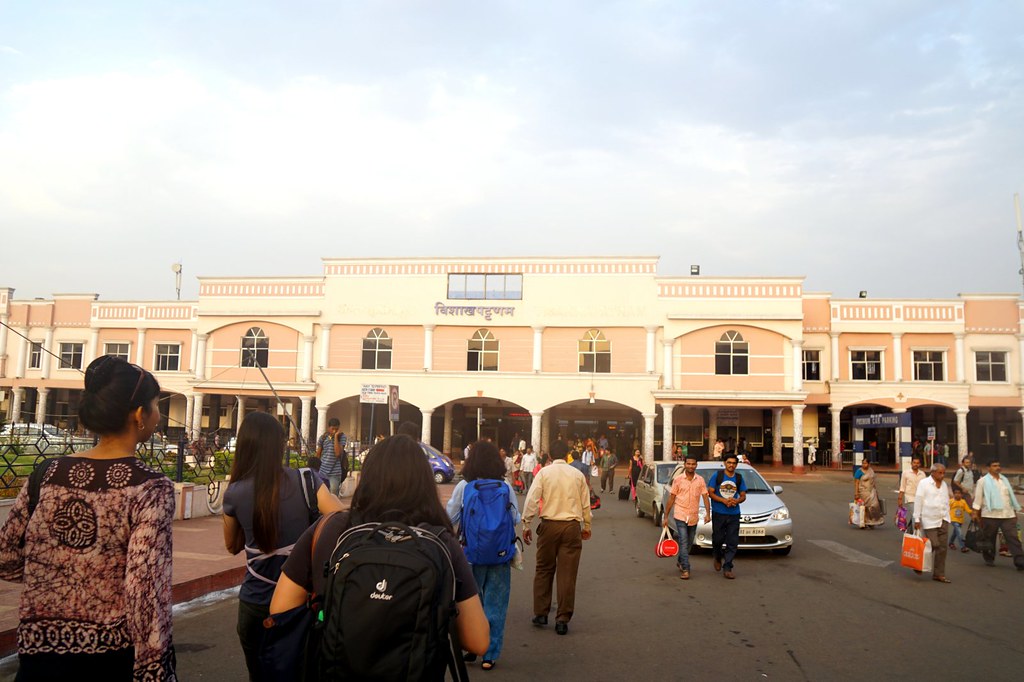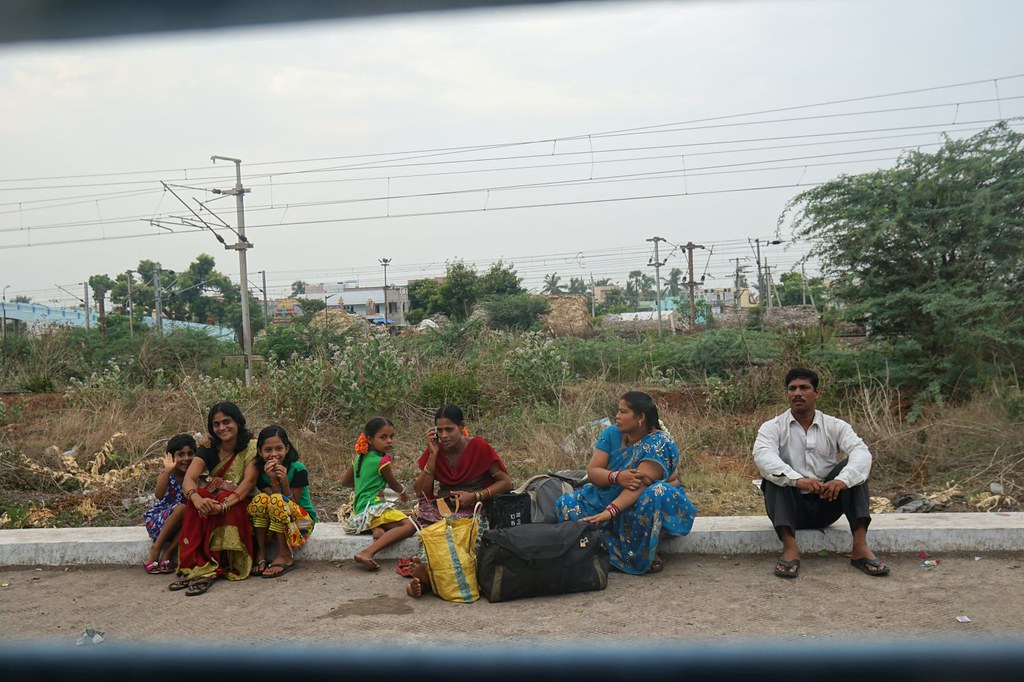It was a dream come true when I was told that Air Asia would be flying me to India.
I took the opportunity to step on Indian soil for the first time, and though it was a part of India unheard of (to me at least), I told myself it would an adventure!
The Visakhapatnam we see today is different from the Visakhapatnam just before Cyclone Hudhud.
It was a tragedy, for most of the Visakhapatnam we saw on this trip were the changed landscape, left from the devastation of Hudhud in October 2014.
It was painful isn’t it, to see the BEFORE and AFTER images here?
This beach (Rishikonda) was destroyed as well.
My tour guide told me it was a very beautiful beach. He is understandably proud of it and as we strolled on the beach, he went on to say it is one of the most popular beach in Vizag.
I would be lying if I say it is beautiful, as it was strewn with rubbish and the water grey. But I reckon that things will improve as Vizag regains her legs. 🙂
All the “before, after” pictures here were photographed by me from the board at Visakha Museum.
It depicts the whole incident clearly, no words needed.
And thus, it made me understand that the Visakhapatnam I see today is still in reborn stage since October 2014, barely 7 months ago.
The roads are bumpy, the air dusty, the beach grey and at times the landscape is dull.
But Vizag offers its own charm (other than food and shopping, both activities I obviously love) for those keen to explore the rougher side of India.
Going around Visakhapatnam:
It would be safer to be part of a tour which covers transportation and most importantly, provide a guide to communicate with the locals. We didn’t try any of the public buses or taxis, and frankly I wouldn’t recommend it.
Over 5 days we took a lot of winding, ascending routes and sometimes were rewarded with views like this.
Though at most hours, the views are like this.
This qualifies as a roundabout and traffic lights are far and in-between.
1. Simhachalam Temple
After a morning walk at Rishikonda Beach, we set out for Simhachalam Temple.
Considering that this is our first sight-seeing venue and our first day in Vizag, I was naturally in decent spirits, though I’m never a fan of temples.
I heard the guide droned on and on about “no cameras allowed” and the “no footwear” rules as I gazed out my window and took my first sight of this revered place of worship.
No footwear allowed is fine. No cameras are fine too. When we were told that even mobiles or bags are not allowed, we tolerantly passed all our belongings to a fellow media who is not stepping into the temple for his safekeeping.
After all it is a scared place of worship and I would humbly abide by its rules.
It was sweltering hot in India in May, and thus I was in shorts and sleeveless. But I had read the itinerary, so I did prepare a long sleeved top and a pair of black pants to wear over my shorts.
BELOW: Our offerings; a bunch of greens. Don’t ask me what.
So yes we went into the temple, though not without a lot of drama.
Now, we are in an Andhra Pradesh Tourism tour, where our guides are from the tourism board itself. However it didn’t hold any significance to the caretakers of the temple.
Rules are rules, no doubt. But getting into the temple was quite a hassle.
We do not understand the language, but the way it was spoken and the treatment given as well as the tone used gave me an idea of their impression of us.
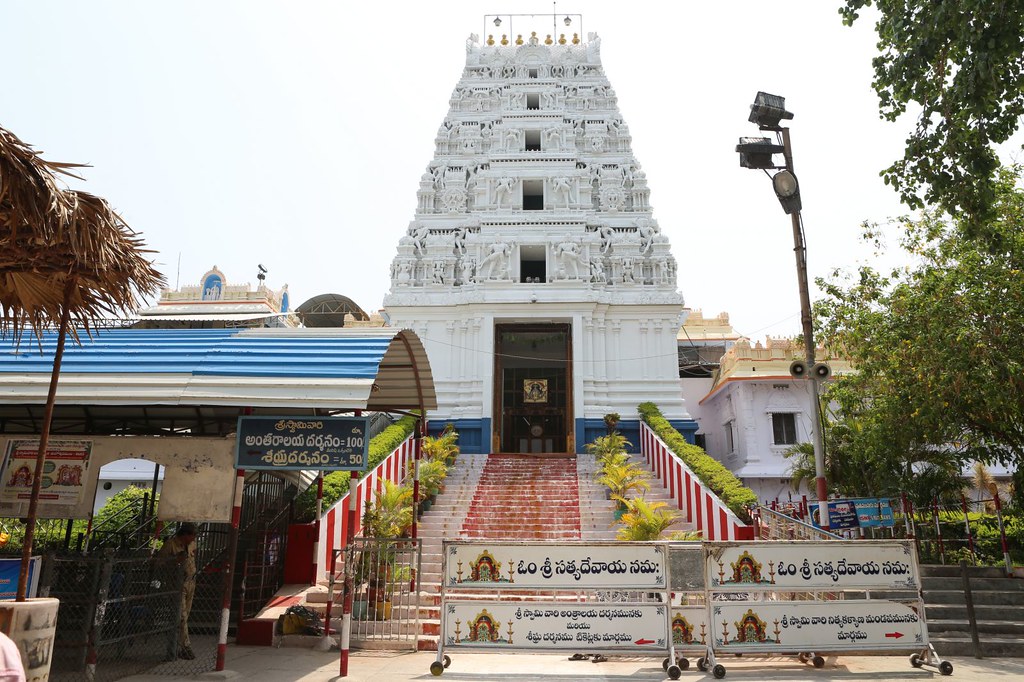
And thus I was thankful that we have local guides, and eventually after much agitation we finally got in.
There are no pictures of the temple within. The temple has an entry and an exit point, where all devotees and visitors abide by.
BELOW: Shoes off and walk at the shaded side up towards the entrance.

Simhachalam is very popular and it is dedicated to “Narasimha” (the man-lion), incarnation of Lord Vishnu.
NOTE: “Simha” means lion; “Adri” or “Achala” means hill.
The unique story goes like this; the God is supposedly a very angry god, and thus must be kept “cooled” under a layer of sandalwood paste all year round and can be seen without sandalwood (“nijaroopa darshan” – holy appearance in true form) for only 12 hours per year.
After that 12 hours, the deity (statue) must be recovered in sandalwood paste.
You are going to have to use your imagination as we were not allowed to take photos and there were no “press photos” provided either.
Just like any other Indian temple, there are a lot of locals (Indians) queueing up for their turn to pray to the deity and be blessed.
However, the similarity stops here. It was May 2015 and summer time in India. The atmosphere inside is oppressively hot with not much air circulating and there are thousands of locals in queue from the entrance to the inner room that housed the deity.
In a inner courtyard there are a dozen men (staff of the temple) in a circle bent over their sandalwood blocks. Their responsibility is to rub blocks of the sandalwood against a big block with a little water.
As they rub it you will notice the water taking on the colour of sandalwood and getting thick in consistency. This thick paste is collected and used to cover the deity, layer after layer, day after day for the whole year.
These workers work 8 hours a day, and their job is solely to extract the sandalwood in the method described above.
When asked, our guide said the sandalwood is from Bangalore.
The sandalwood paste is as pure as it gets but it is not for sale and is produced solely for the Narasimha deity.
After this spectacle we were ushered into the (Garbhagriha) inner sanctum of the temple and queued with the rest for our turn to see, pray and to be blessed by the deity.
The inner room that housed the deity is cool due to the air-conditioning.
Surprise surprise! Yes, there is air conditioning! 🙂
After another long wait we were finally blessed, but not before some minor heated arguments ensued between the guides and the temple people.
During the blessing, the priest in charge would ask for your name, and then chant some prayers of which your name would be mentioned once.
He will then sprinkle some water over your head and at times offer you water from a pot to drink. We were also given some flowers from the god, and told to take some sandalwood paste from a platter he is holding to dab on our foreheads.
At this point you may leave some donations, but that was rather funny, because they haven’t allowed us to bring anything into the temple, so how are we supposed to have rupees on us?
While we were in the temple, we were repetitively reminded not to touch anything. The priest and deity are isolated from the devotees as there are a barrier rope to bar anyone from stepping into the inner space that housed the deity.
We emerged from the temple to head back to our hotel in a 40 minutes journey for lunch (I’ve said in my Visakhapatnam FOOD post here that all our meals are in only APTDC hotels) before the next destination, the Dutch Monuments at Bheemili.
CONCLUSION:
Even after taking into consideration the long queue, the heat, the language barrier and the less-than-welcoming treatment, I would still encourage anyone considering to visit the Simhachalam to do so, for it is a unique experience.
I’ll like to also emphasise that I’m sharing my story based on my experience, and it may or may not be a daily occurrence.
Likewise I also do not wish to paint a rosy picture for my readers, and say that the visit wasn’t without some challenges, largely due to the language barrier.
You can visit Simhachalam Temple on your own, MINUS a guide. But unless you speak the language, or have a local with you, I would advise you to err on the side of caution and go via a tour.
More details on Simhachalam Temple:
Only one main god – the Narasimha deity.
Entry ticket : You will notice that there are many lines at the entrance of the temple.
1st line is free, anyone can go through this line.
2nd is 20 rupees, another lane.
3rd lane is 100 rupees, considered the “fast lane“, which is a good option unless you wish to be slow-baked in the heat.
However this DOES NOT allow you access to the Garbhagriha (inner temple), and certainly NOT to see the deity – the Narasimha.
For 200 rupees, you get to use the 3rd lane (special) and you get to pray/see/request blessings from the deity.
So in conclusion, just take the 200 rupees option ok? 🙂
**Garbhagriha or Garbha gruha (garbha gṛha)is the sanctum sactorum, the innermost sanctum of a Hindu temple where resides the murti (idol or icon) of the primary deity of the temple. Literally the word means “womb chamber”, from the Sanskrit words garbha for womb and griha for house. Only ‘priests’ are allowed to enter this chamber.
TIME:
Open daily 6am to 1130am. 11-30-12pm close for break.
12 pm – 2.30 pm open.
2.30 – 3.30 pm close for break.
3.30-7.30 pm open.
Goody bag for us. I didn’t dare to eat it though it was tempting.
BELOW: Final group picture after our visit.

Our tour took us to 2 temples, the (1) Simhachalam Temple and another one was the (2) Antarvadi Lord Narasimha Swamy Temple.
I was curious at this point; are there big differences in the temples here (architecture, deities) as well as in the treatment of foreigners in the Antarvadi Lord Narasimha Swamy Temple?
Would it be similar or would we be warmly welcomed instead?
2. Antarvadi Lord Narasimha Swamy Temple
We visited the Antarvadi Lord Narasimha Swamy Temple on our third day in Visakhapatnam.
I can’t comment on behalf of the group, but I was personally rather wary.
Appropriately clothed and readily to leave our belongings in the car, I was actually keen to spot the difference.
Antarvadi Lord Narasimha Swamy Temple.

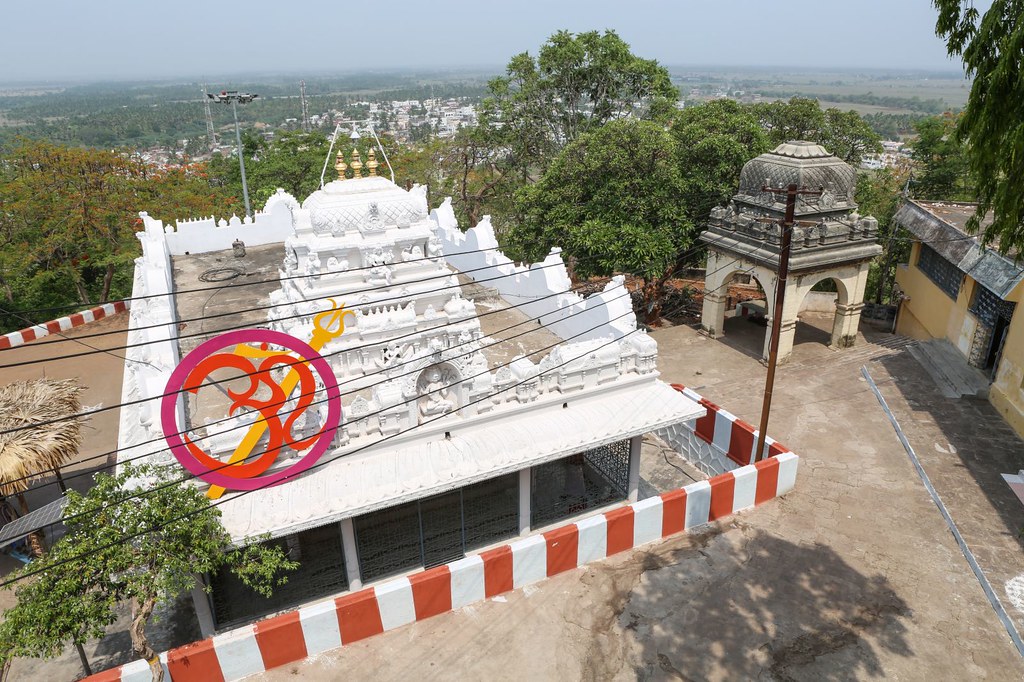
I would say our guides were slightly more organised this time. This temple is bigger too, and even have a small marketplace (just a few stalls) that sells souvenirs.

Here goes, get your imagination to work.
We were barefooted, and half-jogged over the hot floor as we were ushered into a house where we were told to wash our feet and hands.
Yes, we didn’t have to do that at the Simhachalam Temple.
BELOW: The very floor that we had to walk barefooted across.

After we were done cleansing ourselves, we proceeded to enter the temple.
See the 2 kids below? They were barefooted too.
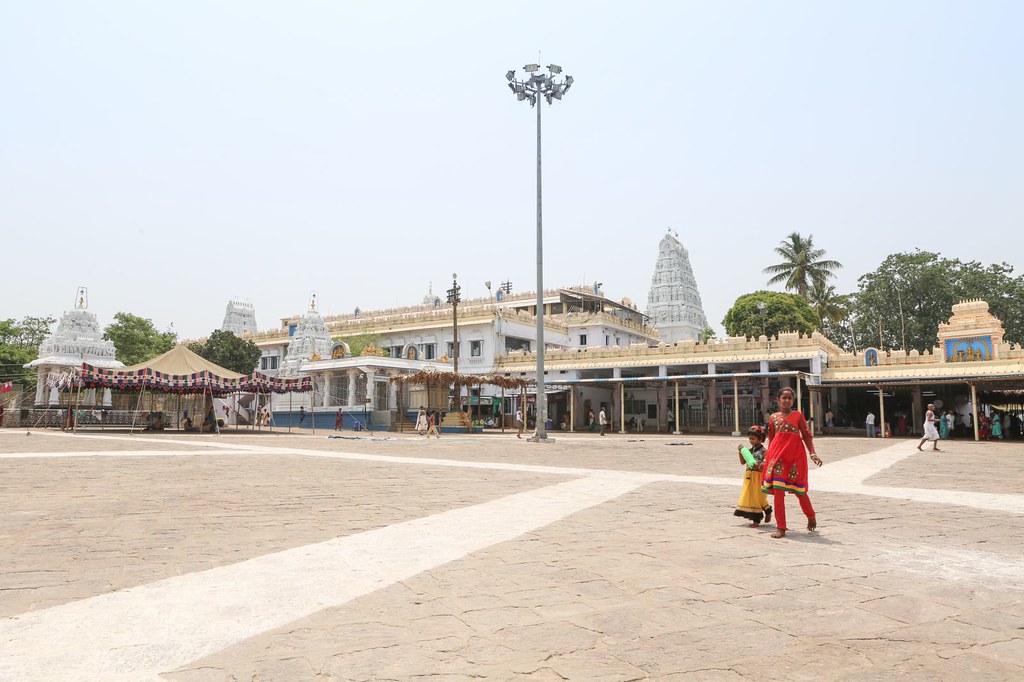
The temple procedure were almost similar. There were no welcoming warmth but noticeably less hostility. As usual we queued to see the main deities.
There are 3 gods here and the main one is said to be very powerful hence the draw of the temple though it is rather remotely located.
The Garbhagriha is air-conditioned as well.
You would have to visit to experience the actual atmosphere and see the design of the temple since no photographs are allowed.
The ritual were similar; give your name to the priest, be blessed, ask for blessings (be it money, career, marriage, etc) and donate if you wish.
**Garbhagriha or Garbha gruha (garbha gṛha)is the sanctum sactorum, the innermost sanctum of a Hindu temple where resides the murti (idol or icon) of the primary deity of the temple. Literally the word means “womb chamber”, from the Sanskrit words garbha for womb and griha for house. Only ‘priests’ are allowed to enter this chamber.

The Antarvadi Lord Narasimha Swamy Temple felt more organized and less crowded than the Simhachalam Temple. There are no sandalwood production here since there isn’t a need for it.
BELOW: Devotees taking a break.
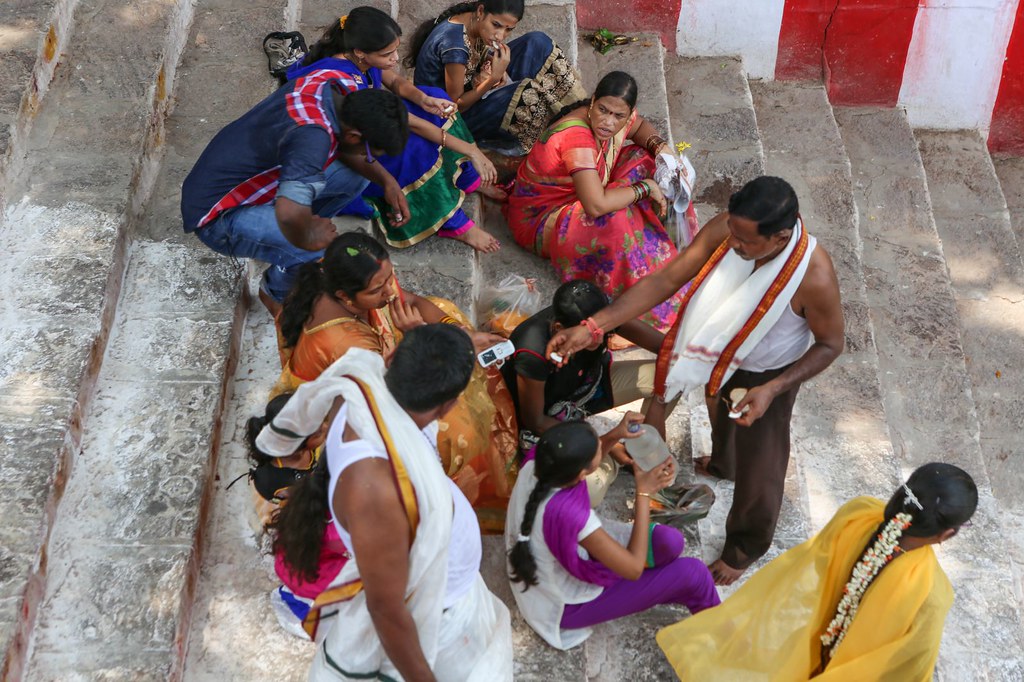
In conclusion was it different?
Well, not much. But of course, the deities are different.
***********************************************************************************************************************
On the 3rd day we took the train to Araku Valley.
I shall began my story at the Visakhapatnam train station.
The first and only train leaves the station by 6.50am and there is only ONE train heading to Araku Valley and ONE train on the return journey each day.
Thus we were told to wake up at the ungodly hour of 4.30am and be in the lobby ready to check out by 5.30am.
3. Araku Valley from Visakhapatnam – the “thrilling” train journey
Now, I’m an early riser, for I’m up by 4.30am back in KL on pretty frequent basis, especially when I need to get some work done.
So I didn’t have a problem. Just bear in mind that Malaysia is 2 hours and 30 minutes ahead of Andhra Pradesh, India. So if your body is still following Malaysian timing, then you might have a problem.
Besides you would want to be at the station an hour earlier at the very least if you haven’t booked your tickets in advance. Yes, you can book them online and I would encourage you to do so!
Anyhow, back to the train.
The train station is by no means impressive or spectacular. It is old, dusty and nothing much Instagrammable.
Bear in mind that this is India, not Switzerland, so keep your expectations in check.
There are a few “classes” available on the train.
Now here is where I have to ask you (my readers) to verify with your guides on the tickets they booked for you.
Our guide said nothing about the different “classes” to us, and booked us on the damn general compartment.
There are first class, and there are sleepers compartment and there are general class.
I found this out AFTER the journey, when I asked for the purpose of this article.
Now I’m not trying to be a princess, but informing us in advance on the appropriate dress code and giving us an idea of what to expect would be nice.
Some of my media friends wore jeans and bought their jackets along, thinking that it is air-conditioned.
I wore a light dress, already having had a taste of the Indian summer the past 2 days and decided that wearing light in India is the way to go.
I’m not sure how the others survived the journey, but they did. In long pants and jeans!
Personally I could barely breathe, sweating buckets until my undergarments were soaked right through within an hour of boarding and they remained wet throughout the 4.5 hours journey.
My thighs were soaked with sweat and stuck to the seat. I stood up a few times so I could “fan” myself, but nope, I was still sweating profusely so that didn’t work.
Also I must clarify that I have high tolerance to heat, for I can’t stand the cold. So you can imagine how stuffy and hot it was to the point that I had difficult getting used to it.
The journey was bumpy, the air still and though there were fans, it didn’t ease the heat and humidity at all.
Even when the train was moving, there wasn’t much air circulating within the cabin. And yes we had all the windows open. Not that you would want to close them anyways!
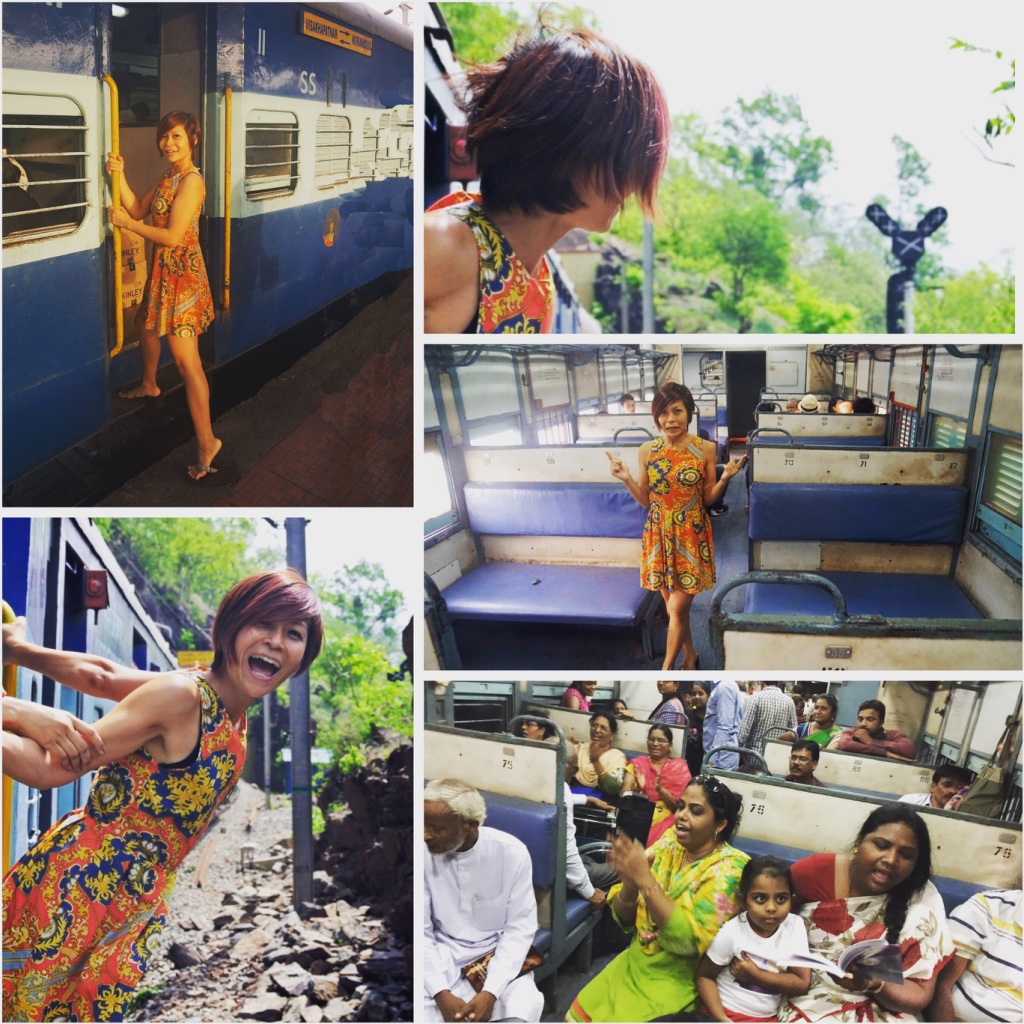
It is a 132 km journey passing though 52 tunnels and 84 bridges. And the train stops at about 15 stations along the way to drop or pick up more passengers.
The longest tunnel is No 35 and 36, combining to be approximately 896.2 meters.
At the passing of each tunnel it seems that it is customary for the locals in the train to start shouting. I couldn’t understand what they were shouting about, but it was in high spirits and sort of marking the passing of each tunnel.
**Note: Numbers above was given by our tour guide. I saw that numbers defers on some online sites.
Needless to say, sleep was futile during the journey. I managed about 1.5 hours throughout the 4.5 hours journey.
Working on the laptop or reading is near impossible.
Seeing how my media friends endured and kept their spirits up throughout the journey was my motivation.
They joked, sang along with the rest of the group in the train at some points of the journey, happily took photos and were generally tolerant of the heat and ruckus.
If they can do it, I can too, I told myself.
BELOW: This bunch is so cool. 🙂

And yes, let’s not forget to talk about the VIEWS along the way.
I wasn’t paying attention for every minute of the journey but the general landscape includes people shitting by the tracks (I kid you not, sadly my camera wasn’t fast enough to zoom in cos I wasn’t having it in my hands then), cows, valleys, locals working at their lands and such.
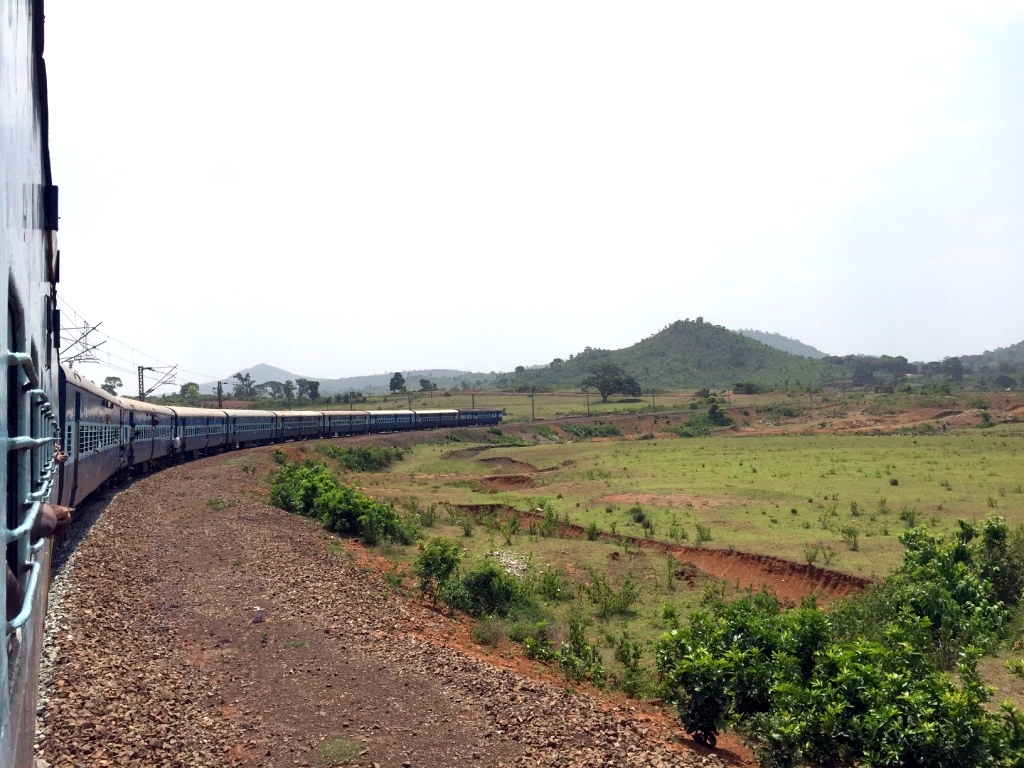
BELOW: An example of a station stop:
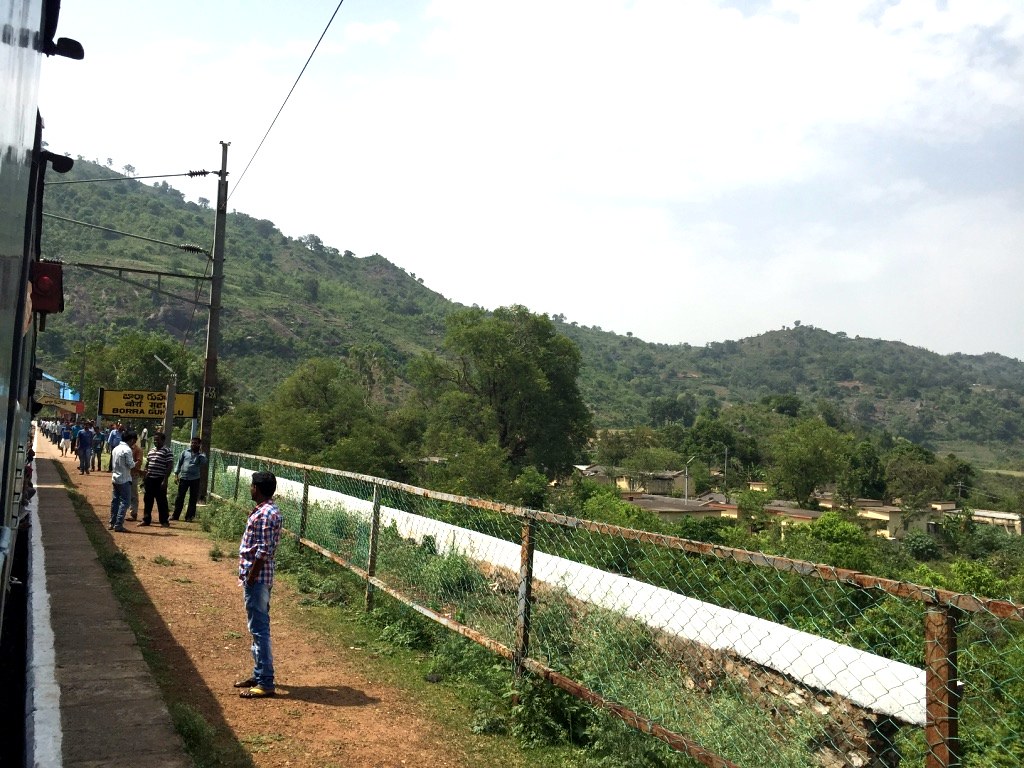
Some parts are green, but for most parts it is dry and stark. Perhaps it was because of summer.

Funny looking tree?

Sustenance:
Food and drinks ( bottled water) were prepared by our tour guide. It wasn’t enough for me for the 4.5hour journey. The sandwich was soggy and had raw tomatoes in it so I didn’t eat that.

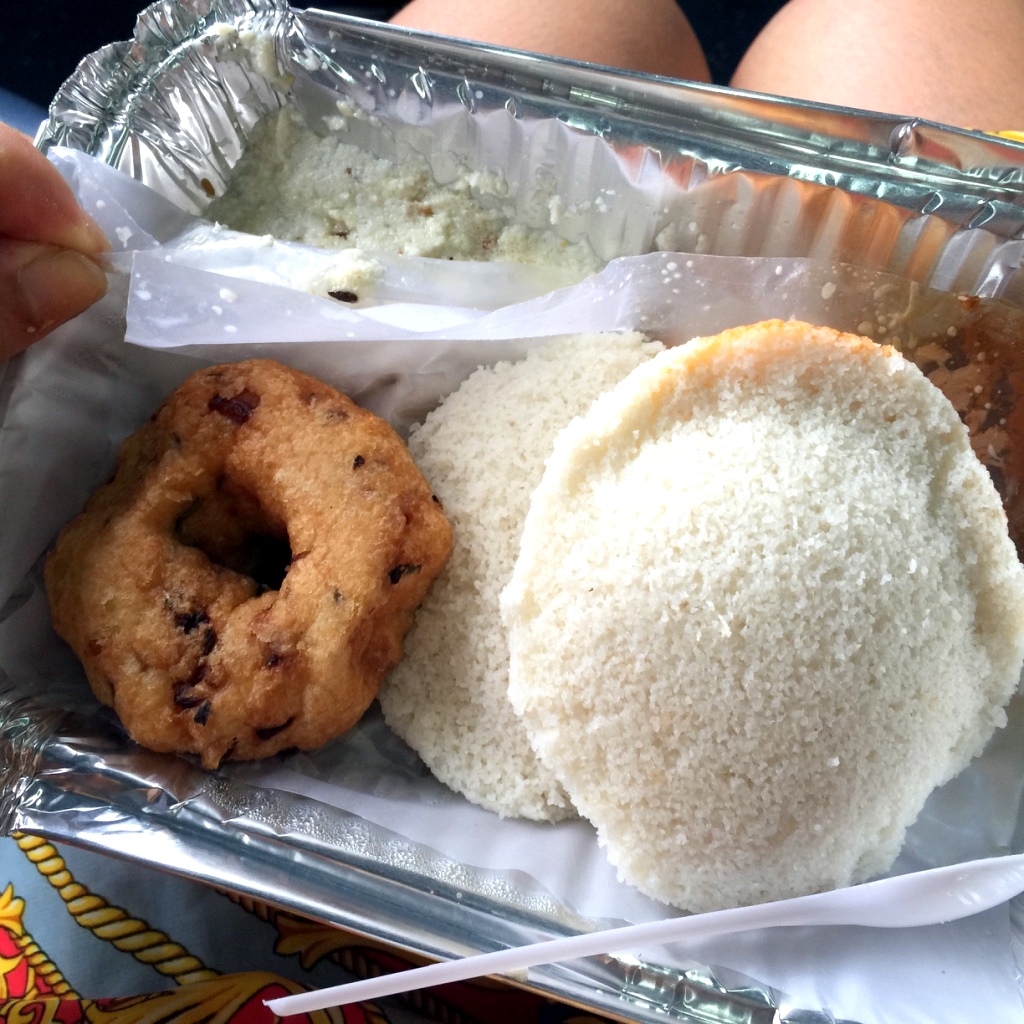
At some stops sellers climb into the compartments to hawk their wares, so you can buy fruits, water, biscuits and more if you choose to do so.
We were all erring on the side of caution so we didn’t try any locally made or cooked food. We didn’t even dare to try the fresh fruits either.

PRICE:
1st class (250 rupees) – air conditioned compartments
General compartment – 30 rupees.
BELOW: Just keep on taking photos to keep ourselves occupied. 😀
4. Borra Caves, Araku Valley
These majestic, 150 million year-old (believed to be & based on online resources) Borra Caves was our targeted destination.
We arrived hungry, groggy and dusty after the long train journey and the cooling interior of the caves welcomed us like a soothing blanket.


The Borra Caves are located in the Anatagiri Hills of Eastern Ghats, near Vishakapatnam, Andhra Pradesh. After our train journey, it took us about an hour on winding roads to reach the entrance of Borra Caves.
Some of us got nauseated while I puked so it is best to be prepared if you are prone to motion sickness.
As usual there were no prior warnings from our guides.
The caves open 100 metres on horizontal plane and about 75 metres on vertical plane.
It was discovered in 1807 by a British Geologist and the total length is measured at 200 metres.
The entire area spreads over 1 sq km and this is where River Gosthani (which flows through the district) originates from.
Borra Caves are located at a height of about 800 to 1300 metres above mean sea level.



As you explore deeper in the caves the occasional illumination comes from the openings in the ceiling as well as lamps of mercury, sodium vapour and halogen.
The tour passage is wide, clean and safe thus there is little chance of accidents. I would caution you to still wear sensible shoes.
I was told there is a lengthy flight of stairs of about 800 steps but we didn’t take that route. I would have loved the exercise if I had not puked my guts out earlier.



There are interesting and unique structures and formations inside the cave which prompted the locals and visitors to give them names such as brains and other animal references.



More on Borra Caves:

Fees & entry timings:



Next, Kalisagiri, the Tribal Museum and more images.
On a side note, we were in the news! Go Air Asia! 🙂
My first trip to India- very eye-opening, with some good and bad. But I’ll definitely be back again, this time for FOOD, SHOPPING and NATURE (beach, hiking).
Many thanks to the new friends I’ve made during this trip for their patience made the whole week so much bearable!
This experience was made possible by the team at Air Asia. Thank you! 😀
AirAsia flies to Visakhapatnam, INDIA every Tuesday, Thursday, Sunday.
Check the flights at www.AirAsia.com.








